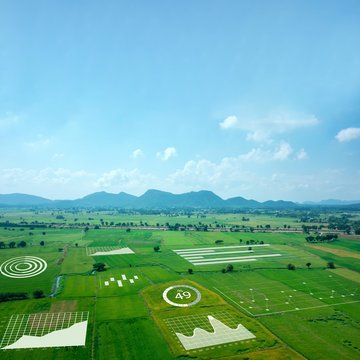A High-tech Way to Protect the Environment
Plants cannot grow without nitrogen. It is an important component in the formation of amino acids and nucleic acids. It is also needed to form the pigment chlorophyll, which plays a crucial role in plant metabolism. Although a large part of the Earth’s atmosphere is made up of nitrogen, a large amount of energy is required to separate the atoms of the N2 molecules from each other. Plants therefore absorb the nitrate (NO3-) found in the soil, which allows nitrogen to be more easily dissolved. Later it is returned to the soil via rotting organic matter: this includes, for example, dead plant parts and the excrement of animals that have in turn feasted on the plants. Nitrate that remains in the soil is decomposed there by anaerobic bacteria and re-enters the atmosphere as nitrous oxide (N2O) and gaseous nitrogen; or it is flushed out and ends up in groundwater. Laughing gas is considered a dangerous greenhouse gas, and high nitrate concentrations in water pose a health risk because it is converted into carcinogenic nitrite in the body. ²
The Nitrogen Dilemma
Beyond Borders
Farmers are faced with a dilemma in plant cultivation: on the one hand, they want to promote plant growth and must ensure that the soil contains enough vital nitrate. On the other hand, they want to work in an as environmentally friendly way as possible and avoid harming the atmosphere and groundwater. They can only achieve both if they always know exactly how much nitrogen the grain currently requires. To make matters worse, the area under cultivation is not a homogeneous mass that is produced in a laboratory; instead, the nitrate concentration of the soil can sometimes vary from one square meter to the next. The yield is correspondingly irregular. In conventional agriculture, an average amount of fertilizer is usually ascertained, which is then spread across the entire field. The trick is to keep the proportion of over-fertilized and under-fertilized areas as low as possible.
The Right Green
Beyond Borders
So-called “sub-area-specific inventory management” aims to solve this dilemma. This involves determining the condition of the soil and the plants in as small a scale as possible and dynamically adjusting the quantity of fertilizer to meet current requirements. Determining the amount of fertilizer while the grain is in the fields is a challenge. Fritzmeier Umwelttechnik GmbH & Co. KG has developed a light-based solution for this. The chlorophyll of plants plays an important role in this process. It is generally known that chlorophyll is responsible for photosynthesis and is thus crucial in the metabolic cycle of plants. At the same time, the amount of chlorophyll in the leaves is a good indication of the nitrogen requirement because the plant uses this to develop the pigment, as well as other things.
Nitrogen deficiency is therefore indicated by the fact that too little chlorophyll is available. Especially older leaves appear light green or yellow and often have brownish tips. The plant hardly grows any more. It appears smaller and paltrier than the others. If there is an oversupply of nitrogen, however, it grows too fast. It produces too many amino acids and proteins and no longer has the strength to form the necessary strengthening tissue. The result is soft, unstable, blue-green colored leaves. The plants are weakened and vulnerable to parasites and diseases. These differences in leaf color are not always visible to the naked eye. However, a sensitive sensor can detect the differences in radiance from which the nitrogen supply of the plants can be deduced. ³
Invisible Indicator
Beyond Borders
The green color results from the absorption behavior of chlorophyll. During photosynthesis, the energy of sunlight is used to convert water and carbon dioxide into glucose, which is needed for metabolism. The plant mainly uses the short-wave blue and the long-wave red part of light for this. The green wavelengths, on the other hand, are reflected, and the leaves appear green. Since chlorophyll production increases with the nitrogen supply, the amount of blue and red light absorbed also increases. At the same time, however, more radiation is reflected in the near infrared range because as more biomass is produced, the more multiple reflections increase on the tissue structures of the plant. The nitrogen requirement of the plant can be calculated from the ratio between this infrared reflection and the reflection in the visible red spectrum. 4
More Yield – Less Environmental Damage
Beyond Borders


Fritzmeier uses this measuring method for its ISARIA PRO Active and ISARIA PRO Compact systems. The sensors are mounted directly on the tractor with which the farmer spreads the fertilizer. With the aid of software, the fertilizer can be controlled based on the amount needed, and each plant receives as much nitrogen as it requires at any given moment. The more economical ISARIA PRO Compact system is designed for use in daylight, while ISARIA PRO Active has its own LED light sources and can be used regardless of the existing lighting conditions. The manufacturer was able to prove in tests that the economic efficiency, for example in grain cultivation, can be increased by more than 10%. The bottom line is that farmers and the environment benefit equally from smart farming.
| 2 | de.wikipedia.org/wiki/Stickstoffkreislauf www.youtube.com/watch?v=nrKRDg4k-bE |
| 3 | www.duenger-und-erde.de/hintergrundwissen/pflanzen-naehrstoffe.html www.bio-gaertner.de/Pflanzenkrankheiten/Naehrstoffmangel-ueberschuss |
| 4 | Sonderdruck aus Getreidemagazin 1/2019, S.2f |
Si Avalanche Photodiodes
Beyond Borders
With a sensitive range of from 260 nm to 1100 nm, silicon photodiodes cover the entire visible spectrum into the near infrared range. They are therefore particularly suitable for use in the visible spectrum. They are inexpensive, easy to manufacture, and are considered to be particularly low noise. For applications where even small amounts of light have to be detected, we recommend Si avalanche photodiodes. With appropriate band-pass filters, specific wavelengths can be used selectively.

Click here
Product selection
LASER COMPONENTS France - Your competent partner for optical and optoelectronic components in France.
Welcome to LASER COMPONENTS S.A.S., your expert for photonics components. Each product in our wide range of detectors, laser diodes, laser modules, optics, fiber optics, and more is worth every Euro (€/EUR). Our customized solutions cover all conceivable areas of application: from sensor technology to medical technology. You can reach us here:
45 Bis Route des Gardes
92190 Meudon
France
Phone: +33 (0) 139 595 225
Email: serviceclient(at)





















